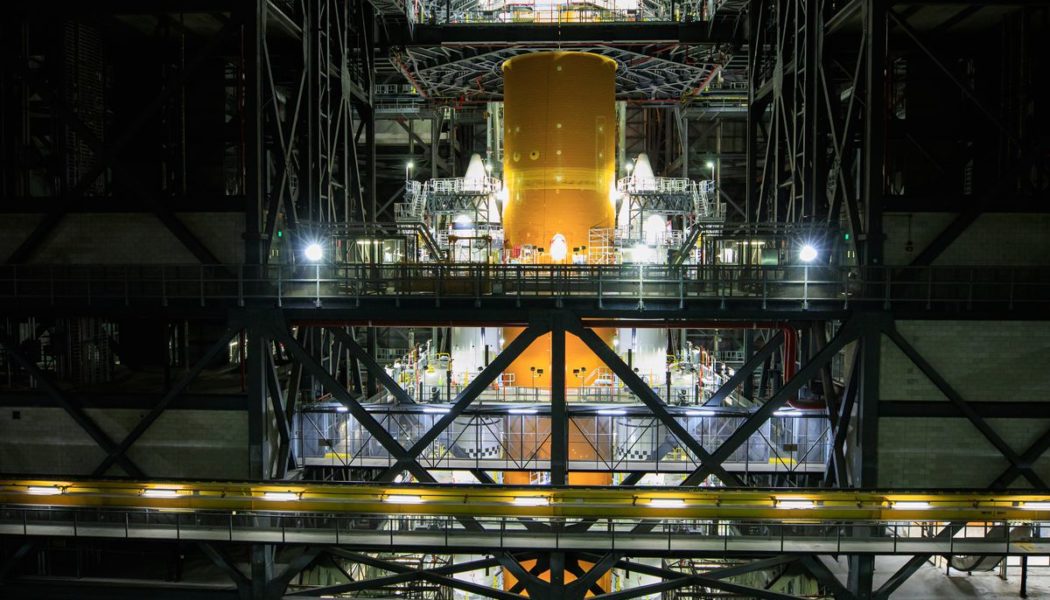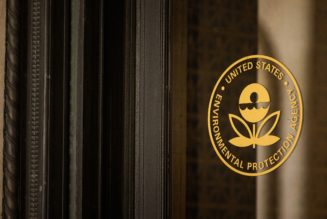NASA is aiming to fly its massive, next-generation rocket, the Space Launch System, for the first time in February of 2022, a critical test flight on NASA’s journey to send people back to the Moon. However, plenty of tests still need to go well before the much-delayed vehicle can finally take flight.
Confirmation of the new target date, which was rumored in August, comes a day after engineers fully stacked the Space Launch System, or SLS, inside NASA’s massive hangar at Kennedy Space Center in Florida. Standing at 322 feet high, the SLS rises taller than the Statue of Liberty. On top of the stack is NASA’s Orion crew capsule, a new spacecraft that’s been developed to carry people into deep space. However, when the SLS flies for the first time next year, there won’t be any people on board. The test mission will send an empty Orion capsule on a four- to six-week-long trip around the Moon.
SLS’ debut flight is known as Artemis I, the first major flight in NASA’s Artemis program. If the flight is successful, the SLS and Orion’s next mission will be Artemis II, which will carry NASA astronauts on a similar trajectory around the Moon. The program will culminate with landing the first woman and the first person of color on the surface of the Moon. During the Trump administration, Vice President Mike Pence challenged NASA to make this landing happen as early as 2024.
That timeline has since been called into question, given the complexity of the mission and numerous delays. Originally, NASA envisioned the SLS flying for the first time back in 2017, but its debut has been consistently pushed back again and again due to improper management and cost overruns. In the meantime, NASA also needs a lunar lander to bring people down to the surface of the Moon, which the SLS and Orion can’t do alone. The space agency awarded SpaceX a contract to develop its new vehicle, called Starship, to take people to the Moon’s surface. But the vehicle still has a long road of development ahead, and lawsuits filed by competitor Blue Origin, which did not receive the NASA contract, have complicated the process. Then there is still the matter of developing new spacesuits, which could also hold up the timeline.
:no_upscale()/cdn.vox-cdn.com/uploads/chorus_asset/file/22948354/51619125454_6f739e438d_o.jpg)
Despite all that, NASA hasn’t quite given up on the 2024 target date, even after Joe Biden became president. “It’s a stretch, it’s a challenge, but the schedule is 2024,” NASA administrator Bill Nelson said in June. Nelson also recently acknowledged the sheer amount of work and obstacles that need to be overcome.
For now, NASA is mostly focused on getting Artemis I off the ground. If all goes well, NASA plans to roll out the fully stacked SLS out to the launchpad late this year. Early next year, the mission team will conduct what’s known as a wet dress rehearsal, where they will fill the rocket with the same propellants it will use for flight but without igniting the rocket’s engines. Once that’s complete, NASA will then roll the rocket back to its hangar for additional checks before rolling it to the launchpad again ahead of the flight.
“I tell you I couldn’t be prouder of the team that got us to where we are today, despite the multiple challenges that we faced with COVID and major storms — most recently, Hurricane Ida — and the impacts that had on our testing facilities,” John Honeycutt, the SLS program manager at NASA’s Marshall Space Flight Center, said during a press conference today.
As of now, Artemis I has three different launch windows: one in February, one in March, and one in April. Each window, dictated by how the Earth is moving about its axis and the Moon’s rotation around our planet, is roughly 15 days long, with the first window opening on February 12th. The timing of the launch within the window dictates how long Artemis I will stay in space, making it either a four-week mission or a six-week mission.
Once Artemis I is complete, then comes Artemis II with a target launch date sometime in 2023. For that flight, people will be on board, which means the vehicle will need even more additions, notably a life support system. NASA would not say whether the latest SLS delays have pushed back Artemis II, only that an update is on its way.
“I think the agency is continuing to look at that; we’re evaluating the status of that mission,” Tom Whitmeyer, deputy associate administrator for exploration systems development at NASA, said during today’s press conference.









